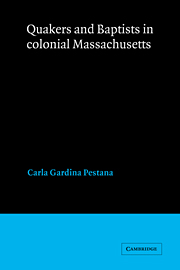4 - Organizational maturation
Published online by Cambridge University Press: 22 October 2009
Summary
By the end of the seventeenth century, both the Baptist church and the Quaker meeting had become fairly structured and had laid the groundwork for further organizational development. The marked contrast between the religious institutions of the eighteenth century and the precariously established communities of the mid-seventeenth century suggests that both sects gradually became staid and respectable, giving up various radical qualities. In broad outline, their histories conform to sociological models of sectarian development as each took on the characteristics of a church and became more routinized with time.
The Baptists and the Quakers arrived at the more churchlike form of the later colonial period by very different paths, however, and achieved dissimilar results. The Baptist church evolved its institutional trappings gradually, drawing upon biblical models it had consistently venerated. In contrast, the Quaker meeting accepted organizational reforms only after tremendous upheaval within the meeting and concerted pressure from outside it. The structure the Quakers eventually erected forestalled some of the compromises usually associated with sectarian evolution. In such basic areas as sectarian discipline, the Baptists and Quakers developed distinctive traditions.
By the turn of the century, the Baptists and Quakers had adopted many of the same basic organizational forms. Both had abandoned the earlier practice of meeting in private homes, taking the symbolically significant step of building their own meetinghouses. As in other areas, the Baptists embraced this symbol of legitimacy first. They erected a meetinghouse on the bank of the Mill Pond in the North End of Boston in 1679 on property owned by two members, Phillip Squire and Ellis Callendar.
- Type
- Chapter
- Information
- Quakers and Baptists in Colonial Massachusetts , pp. 85 - 101Publisher: Cambridge University PressPrint publication year: 1991



